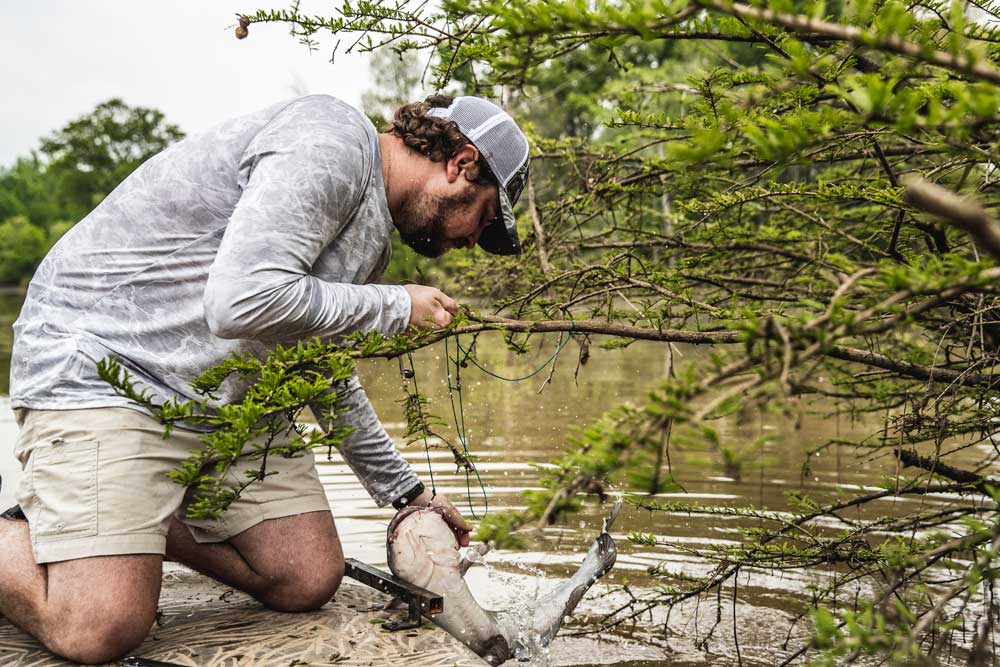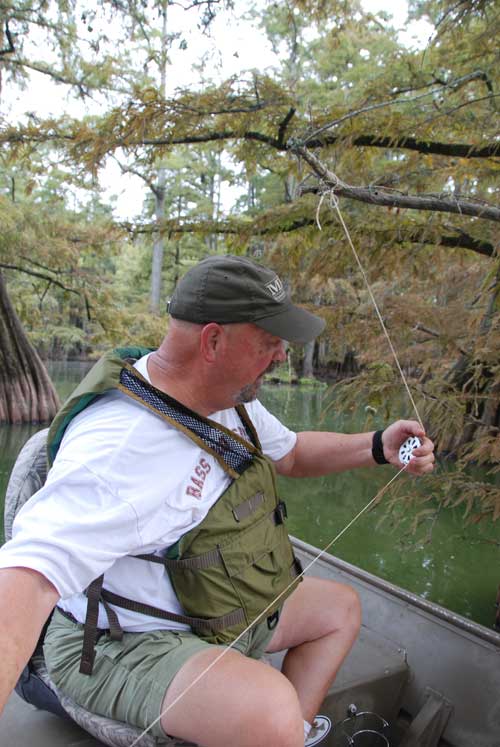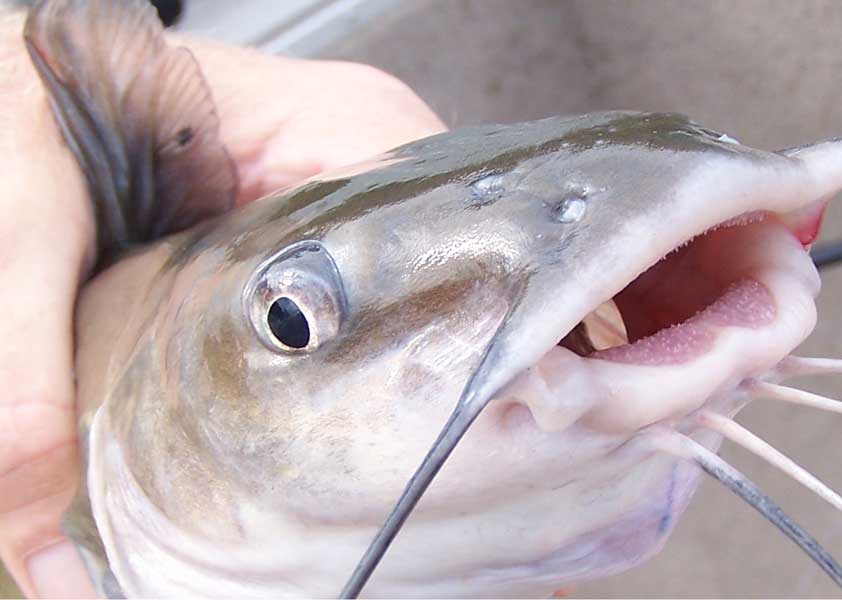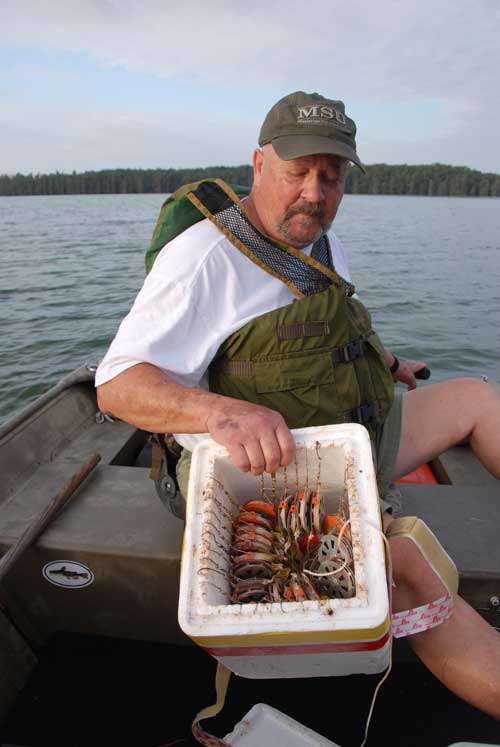Phillip Gentry

Commercial non-game fishing devices run the gamut from trotlines and limb lines to jugs, baskets and a variety of nets. One of the lesser-known, but locally popular, non-game freshwater fishing devices that still sees wide use today is called a yo-yo or automatic fishing reel. As a fishing device, the yo-yo is unique for not relying on a spinning reel or a rotating spool. Instead, it automatically sets a hook when a fish bites.
Yo-yo fishing is a variation of limb line fishing with a mechanical twist. Between the limb and the line is a spring-loaded retractable reel on a stainless steel spring, similar in principle to the pull-start of a push lawnmower. The line is pulled out and a release stops the coil in the reel from retracting. When a fish takes the bait, it pulls the line, the wire or flat trigger is released and the coil winds the line in, both setting the hook and fighting the fish and will often pull a smaller fish right out of the water.
Some versions, such as the Cuban yo-yo, don’t include a spring-loaded mechanism. Instead, they rely on a hand reel and a manually cast line, such as the type found in survival kits. The yo-yo angler simply keeps a direct feel on the line until the fish bites, at which point they pull back by manually winding the line around the spool. Many Cuban yo-yos are DIY projects, making them a cheap and cost-effective solution for catfishing.
Due to its non-game status in many states, catfish are the most frequently sought target when using a yo-yo as a fishing reel.

What to Catch with a Yo-Yo
All species of catfish get lumped together as scavengers, when in truth, specific baits all have different appeals depending upon the type of catfish you’re after. It’s a well-known fact among veteran catfish anglers that flathead catfish will turn up their nose at artificial lures or anything other than freshly cut bait and whole live bait. Blue catfish tend to be more opportunistic feeders but still depend largely on fresh fish, mussels and crayfish for their diet.
You can even attach jigs to a yo-yo hook, making it a more versatile fishing tool that can also attract and catch fish with a keener sense of vision. Examples include crappies, some species of bass and even trout.
Catching Channel Catfish with a Yo-Yo
If there is a true scavenger in the group, it’s the channel catfish. But the label “scavenger” is mostly a misnomer, owing largely to the channel catfish’s highly developed olfactory senses. Catfish have olfactory pits on each side of their head. Each pit has two nostrils.
Water comes in one nostril and goes out the other. The olfactory pit has folds inside that are lined with sensitive tissue for detecting food. In comparison, a rainbow trout has about 18 folds while a largemouth bass has roughly a dozen. Channel catfish have 140 of these folds in each nostril granting it the capability to detect one part of food in 10 billion parts of water.
The weight of a grown channel catfish may vary a lot, ranging from just a few pounds to upwards of 20. If you plan to go channel catfishing with a yo-yo, ensure you use a durable, heavy-duty model made of steel or aluminum. They will be able to withstand the pulling forces generated by the biggest fish. Lighter and less durable models, such as plastic yo-yos, can bind or even break under these forces.
Baits to Use When Yo-Yo Catfishing
Channel catfish are bottom-feeders that extensively rely on their sense of smell to feed, similar to carp. Thanks to their kene olfactory senses, channel catfish will eat nearly anything, especially with an odor, so anglers use a variety of smelly baits, including minnows, cut fish like shad or crappie and worms, which makes the channel catfish a good target when yo-yo fishing.
If there is one bait with the potential of outshining the rest when it comes to enticing channel catfish, it’s stink bait. As stink baits get a bad rap from anglers who have never tried them, or possibly never been successful using them, bait manufacturers have attempted to soften the name by rebranding the gooey, peanut butter-like substance as dip baits.

Dip baits are frequently sold commercially with tackle designed to absorb the paste or at least provide a porous substrate for the bait to adhere to. Dip baits are often sold in small tubes or packets to minimize the angler’s handling of the bait, making them an excellent addition to your yo-yo fishing gear.
Locations for Yo-Yo Catfishing
The best locations for fishing with yo-yos are either piers and boat docks or areas with standing timber. The latter is a better choice for anglers wanting to fish several of the devices, where permitted by law. The line is attached to an overhead limb and enough line is set to allow the bait to settle in the water column, usually just above the bottom.
EVERYTHING YOU NEED TO CATCH CATFISH
In days gone by, many commercially motivated catfishermen would set yo-yos in the same fashion as trotlines and come back later to check them. This practice frequently resulted in the waste and loss of by-catch – smaller catfish and game species that would be pulled out of the water and suffocate.
For this reason, many states have enacted laws requiring anglers fishing with yo-yos to attend these fishing devices at all times. Attendance means that the anglers must remain in sight of the yo-yos if the gears are set and baited or set and tripped. Additional regulations may permit the devices to remain unattended for a short period during the middle of the day if the devices are tripped and hooks are not in the water.
Yo-Yo Care and Maintenance Tips
Care and maintenance for yo-yos used for catfishing is pretty simple. It’s best to allow the devices to air dry after use. If your yo-yo is spring-loaded, you’ll need to keep every moving part properly lubricated and cared for to prevent degradation and malfunctions. Always keep a can of WD-40 in your fishing kit.

When your coils aren’t in use, apply a thin coat of WD-40 or other spray lubricant to protect them from rust. Regularly test your yo-yo’s spring tension. If it feels loose or can’t retract your line properly, your yo-yo may be worn out and require repairs or replacement.
If you use a manual device, such as a Cuban yo-yo, maintenance is even simpler. Just inspect your spool or hand reel for signs of cracks or surface damage. If your Cuban yo-yo has rough edges or splinters, sand the surface down until it is smooth again to prevent your line from coiling, snagging or wearing out.
Many anglers tie swivels to the end of the yo-yo line to make it easier to attach lines. Others use a Styrofoam cooler or pool noodle to wrap lines after use so they don’t get tangled.
As with any other fishing tools, inspect your fishing lines for signs of wear and tear, such as frays, nicks or weak spots. Avoid storing your yo-yo and your fishing lines in direct sunlight to avoid line degradation. If one of your fishing lines is worn or close to breaking, replace it as soon as possible.































